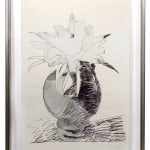Andy Warhol USA, 1928-1987
Flowers [Black & White], 1974
Original screen print initialled by the artist lower right,
Signed by the artist verso
F & S 11.104
Signed by the artist verso
F & S 11.104
102.87 x 69.21 cm - Sheet
124.46 x 90.17 cm - Framed
124.46 x 90.17 cm - Framed
© The Estate of Andy Warhol
£ 15,450 + ARR
Further images
Andy Warhol's Flowers (Black & White) represents a significant departure from his earlier, more colourful flower series and marks a significant evolution in his artistic approach. This piece is part...
Andy Warhol's Flowers (Black & White) represents a significant departure from his earlier, more colourful flower series and marks a significant evolution in his artistic approach. This piece is part of a portfolio of 10 prints created in 1974, featuring hand-drawn depictions of various flowers.
Unlike his vibrant Flowers series from 1964, based on a photograph of hibiscus blossoms and utilising his signature silkscreen technique, his black and white series created a decade later demonstrates a more personal and intimate side of Warhol's work. Here, introducing a visibly hand-drawn element in these works signifies a notable progression in his artistic practice.
The black and white rendition of the flowers strips away the commercial appeal and pop culture associations typically found in Warhol's work. By removing colour, Warhol signals the viewer to focus on the form and composition of the flowers themselves. This approach contrasts with his earlier, more recognisable works, demonstrating Warhol's versatility as an artist.
The significance of this series lies in its departure from Warhol's mechanical reproduction techniques. While his earlier works often emphasised repetition and mass production, the hand-drawn quality of the present Flowers reveals a personal touch. This shift can be interpreted as Warhol's exploration of traditional artistic techniques and a return to a more direct form of artistic expression.
In the context of Warhol's oeuvre, Flowers (Black & White) from 1974 represents a bridge between his pop art roots and a more expressive, haptic phase. It demonstrates his ability to reinterpret familiar subjects in new ways, challenging viewers' expectations and perceptions of his work. The series also showcases Warhol's enduring fascination with nature as a subject, albeit approached from a different aesthetic perspective than his earlier Pop Art flower prints.
Unlike his vibrant Flowers series from 1964, based on a photograph of hibiscus blossoms and utilising his signature silkscreen technique, his black and white series created a decade later demonstrates a more personal and intimate side of Warhol's work. Here, introducing a visibly hand-drawn element in these works signifies a notable progression in his artistic practice.
The black and white rendition of the flowers strips away the commercial appeal and pop culture associations typically found in Warhol's work. By removing colour, Warhol signals the viewer to focus on the form and composition of the flowers themselves. This approach contrasts with his earlier, more recognisable works, demonstrating Warhol's versatility as an artist.
The significance of this series lies in its departure from Warhol's mechanical reproduction techniques. While his earlier works often emphasised repetition and mass production, the hand-drawn quality of the present Flowers reveals a personal touch. This shift can be interpreted as Warhol's exploration of traditional artistic techniques and a return to a more direct form of artistic expression.
In the context of Warhol's oeuvre, Flowers (Black & White) from 1974 represents a bridge between his pop art roots and a more expressive, haptic phase. It demonstrates his ability to reinterpret familiar subjects in new ways, challenging viewers' expectations and perceptions of his work. The series also showcases Warhol's enduring fascination with nature as a subject, albeit approached from a different aesthetic perspective than his earlier Pop Art flower prints.
出版品
Feldman & Schellmann: Andy Warhol Prints, A catalogueRaisonne 1962/1987 : Number 11.104Join our mailing list
* denotes required fields
We will process the personal data you have supplied to communicate with you in accordance with our Privacy Policy. You can unsubscribe or change your preferences at any time by clicking the link in our emails.
![Andy Warhol, Flowers [Black & White], 1974](https://artlogic-res.cloudinary.com/w_1600,h_1600,c_limit,f_auto,fl_lossy,q_auto/artlogicstorage/dellasposa/images/view/23afc02c75d67bd206f5abfb7a03b792j/dellasposa-andy-warhol-flowers-black-white-1974.jpg)
![Andy Warhol, Flowers [Black & White], 1974](https://artlogic-res.cloudinary.com/w_1600,h_1600,c_limit,f_auto,fl_lossy,q_auto/artlogicstorage/dellasposa/images/view/5bc37e09fa1d975bcb07b8e8e0669b39j/dellasposa-andy-warhol-flowers-black-white-1974.jpg)
![Andy Warhol, Flowers [Black & White], 1974](https://artlogic-res.cloudinary.com/w_1600,h_1600,c_limit,f_auto,fl_lossy,q_auto/artlogicstorage/dellasposa/images/view/09240f24b8a4ac7b29b938d93a5b0036j/dellasposa-andy-warhol-flowers-black-white-1974.jpg)
![Andy Warhol, Flowers [Black & White], 1974](https://artlogic-res.cloudinary.com/w_1600,h_1600,c_limit,f_auto,fl_lossy,q_auto/artlogicstorage/dellasposa/images/view/b025696c01ab8107f7e9b170386358faj/dellasposa-andy-warhol-flowers-black-white-1974.jpg)
![Andy Warhol, Flowers [Black & White], 1974](https://artlogic-res.cloudinary.com/w_1600,h_1600,c_limit,f_auto,fl_lossy,q_auto/artlogicstorage/dellasposa/images/view/2f907c7c3cbdd51b1a9da1b39df18ea9j/dellasposa-andy-warhol-flowers-black-white-1974.jpg)
![Andy Warhol, Flowers [Black & White], 1974](https://artlogic-res.cloudinary.com/w_1600,h_1600,c_limit,f_auto,fl_lossy,q_auto/artlogicstorage/dellasposa/images/view/561572ee2bd267863981227b62a10fc3j/dellasposa-andy-warhol-flowers-black-white-1974.jpg)





